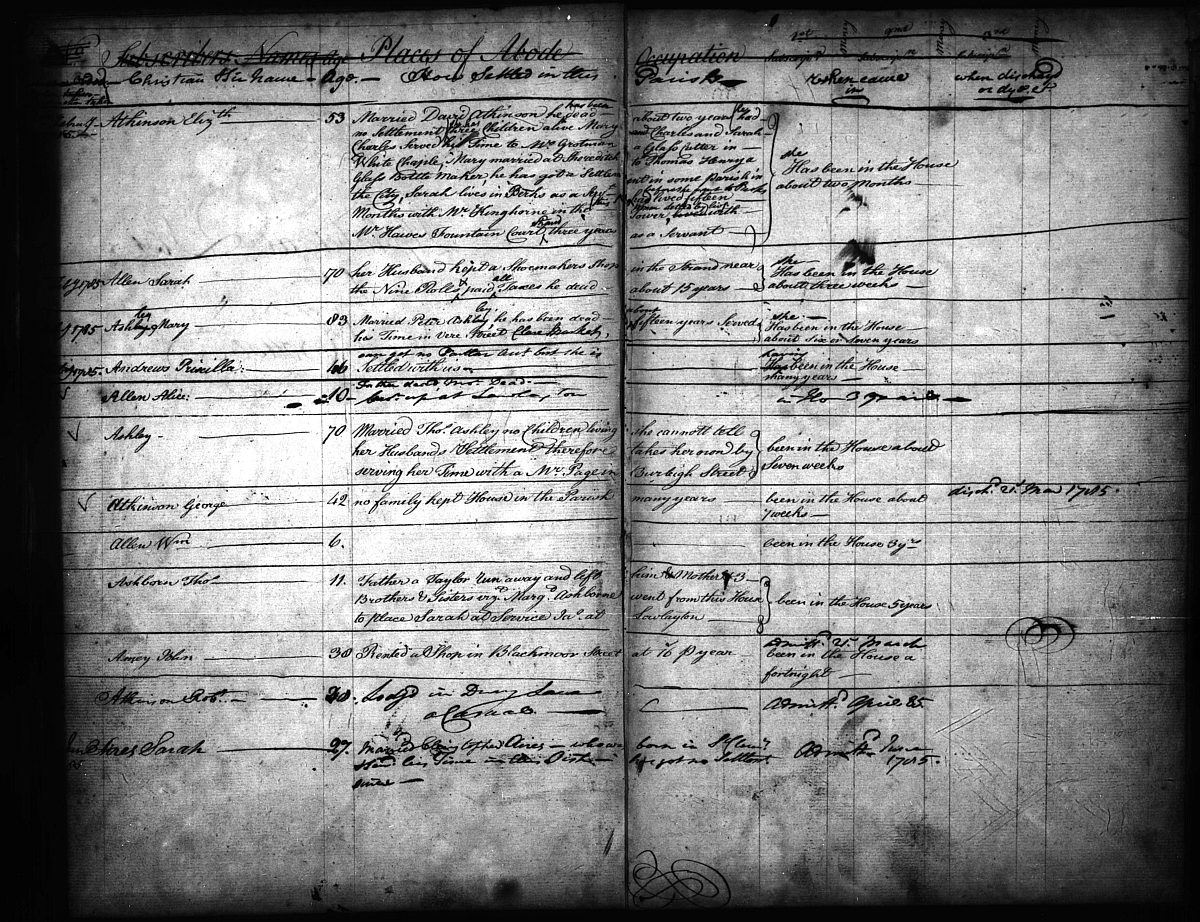List of Inmates of St Clement Danes Workhouse in 1785 (LW)
 St Clement Danes, Alphabetical List of the House, 1785, Ms B1247, LL ref: WCCDLW360000006&7.
St Clement Danes, Alphabetical List of the House, 1785, Ms B1247, LL ref: WCCDLW360000006&7.
Introduction
The detailed census of workhouse inmates produced by the parish of St Clement Danes forms a rare contemporary snapshot of the population of a single institution in a single month - February 1785. The census itself appears to have been constructed as part of a thorough-going investigation of the relief provided by the parish. The inclusion of a list of inmates ordered for discharge from the workhouse towards the end of the volume suggests that this review resulted in a significant number of people being excluded from the house. This kind of spring "clear-out" was commonplace to many eighteenth-century workhouses and reflected a strong seasonal component in both employment and the demand and provision of poor relief. As spring approached even elderly and unskilled paupers were more able to gain a livelihood in either agriculture or as itinerant trades people, and they were expected to survive independently over the summer, even if they returned to the workhouse in the autumn.1
Historical Background
St Clement Danes established its first substantial workhouse in the early 1770s, and by the mid-1780s had instituted a comprehensive programme of workhouse care for the adult poor, in combination with rural nursing at Enfield for children under six, and industrial apprenticeships to large northern textile mills for older children.2 By the same date, and following a period of severe public criticism at the hands of Jonas Hanway, the parish had also attracted the reputation as the best casualty parish in Westminster, meaning that the poor found relief in the parish easy to obtain.
Layout and Content
The title page of the volume provides a clear statement of its content:
The volume itself was originally laid out to record subscriptions to an unknown charity, but was then re-purposed to record the workhouse census. Each tabbed two-page opening is laid out as a single table with the inmate's name and age in two columns on the left. Next to this, in a wide column that extends across the volume's gutter, is a statement of the circumstances of the pauper along with information about the basis for their claim to a settlement in the parish. To the right of this are two further columns labelled when came in and when discharged in which information about the pauper's length of stay in the house is recorded. The census filled only around half the volume, and some of the remaining space is used to record details of warrants and receipts, and to illustrate how the parish clerk might lay out the form of a register of apprentices.
Because this table format does not reproduce well in transcription, it is best to look at the associated original page images.
Introductory Reading
- Hindle, Steve. On the Parish?: The Micro-Politics of Poor Relief in Rural England, c.1550-1750. Oxford, 2004.
- Hitchcock, Tim. Down and Out in Eighteenth-Century London. 2004, ch. 6.
- Neate, Alan Robert. The St Marylebone Workhouse and Institution, 1730-1965. Rev. edn, 2003.
- Snell, Keith D. M. Parish and Belonging: Community, Identity, and Welfare in England and Wales, 1700-1950. Cambridge, 2006.
- Tomkins, Alannah. The Experience of Urban Poverty, 1723-82: Parish, Charity and Credit. Manchester, 2006.
Online Resources
For further reading on this subject see the London Lives Bibliography.
Documents Included on this Website
- St Clement Danes, Alphabetical List of the House, 1785, Westminster Archives Centre, Ms. B1247, LL ref: WCCDLW36000, Tagging Level: C
Footnotes
1 For a wider discussion of the role of seasonality in the working of relief and settlement see Keith D. M. Snell, Settlement, Poor Law and the Rural Historian: New Approaches and Opportunities, Rural History, 3:2 (1992), pp. 145-72. Though focussed on the nineteenth century, the classic work on this issue in relation to London is Raphael Samuel, Comers and Goers, in H. J. Dyos and Michael Wolf, eds, The Victorian City, Images and Realities (1973), vol. 1, pp. 123-160. ⇑
2 See Katrina Honeyman, Child Workers in England, 1780-1820: Parish Apprentices and the Making of the Early Industrial Labour Force (Aldershot, 2007). ⇑